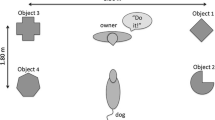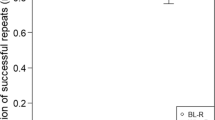Abstract
Memory processing in nonhuman animals has been typically tested in situations where the animals are repeatedly trained to retrieve their memory trace, such as delayed matching to sample, serial probe recognition, etc. In contrast, how they utilize incidentally formed memory traces is not well investigated except in rodents. We examined whether domestic dogs could solve an unexpected test based on a single past experience. In Experiment 1, leashed dogs were led to 4 open, baited containers and allowed to eat from 2 of them (Exposure phase). After a walk outside for more than 10 min, during which time the containers were replaced with new identical ones, the dogs were unexpectedly returned to the site and unleashed for free exploration (test phase). Eleven out of 12 dogs first visited one of the containers from which they had not eaten. In Experiment 2, two containers had food in them, one had a nonedible object, and the last one was empty. Dogs visited all 4 containers and were allowed to eat one of the food rewards in the Exposure phase. In the test phase, unleashed dogs first visited the previously baited container from which they had not eaten significantly more often than chance. These results demonstrate that in an unexpected, test dogs may retrieve “what” and “where” information about seen (now invisible) items from incidental memory formed during a single past experience.


Similar content being viewed by others
References
Adachi I, Kuwahata H, Fujita K (2007) Dogs recall their owner’s face upon hearing the owner’s voice. Anim Cogn 10:17–21
Babb SJ, Crystal JD (2005) Discrimination of what, when, and where: implications for episodic-like memory in rats. Learn Motiv 36:177–189
Call J, Bräuer J, Kaminski J, Tomasello M (2003) Domestic dogs are sensitive to the attentional state of humans. J Comp Psychol 117:257–263
Clayton NS, Dickinson A (1998) Episodic-like memory during cache recovery by scrub jays. Nat 395:272–274
Eacott MJ, Norman G (2004) Integrated memory for object, place, and context in rats: a possible model of episodic-like memory? J Neurosci 24:1948–1953
Eacott MJ, Easton A, Zinkivskay A (2005) Recollection in an episodic-like memory task in the rat. Learn Mem 12:221–223
Easton A, Zinkivskay A, Eacott MJ (2009) Recollection is impaired, but familiarity remains intact in rats with lesions of the fornix. Hippocampus 19:837–843
Ennaceur A, Delacour J (1988) A new one-trial test for neurobiological studies of memory in rats. 1: behavioral data. Behav Brain Sci 31:47–59
Fiset S (2007) Landmark-based search memory in the domestic dog (Canis familiaris). J Comp Psychol 121:345–353
Fiset S, Beaulieu C, Landry F (2003) Duration of dogs’ (Canis familiaris) working memory in search for disappearing objects. Anim Cogn 6:1–10
Fiset S, Beaulieu C, LeBlanc V, Dube L (2007) Spatial memory of domestic dogs (Canis familiaris) for hidden objects in a detour task. J Exp Psychol Anim Behav Process 33:497–508
Fujita K (2009) Metamemory in tufted capuchin monkeys (Cebus apella). Anim Cogn 12:575–585
Good MA, Hale G, Staal V (2007) Impaired “Episodic-like” object memory in adult APPswe transgenic mice. Behav Neurosci 121:443–448
Hampton RR (2001) Rhesus monkeys know when they remember. Proc Nat Acad Sci USA 98:5359–5362
Hare B, Call J, Tomasello M (1998) Communication of food location between human and dog (Canis familiaris). Evol Commun 2:137–159
Hare B, Brown M, Williamson C, Tomasello M (2002) The domestication of social cognition in dogs. Science 298:1636–1639
Kaminski J, Bräuer J, Call J, Tomasello M (2009) Domestic dogs are sensitive to a human’s perspective. Behaviour 146:979–998
Kart-Teke E, De Souza Silva MA, Huston JP, Dere E (2006) Wister rats show episodic-like memory for unique experiences. Neurobiol Learn Mem 85:173–182
Lakatos G, Soproni K, Dóka A, Miklósi Á (2009) A comparative approach to dogs’ (Canis familiaris) and human infants’ comprehension of various forms of pointing gestures. Anim Cogn 12:621–631
Li J-S, Chao Y-S (2008) Electrolytic lesions of dorsal CA3 impair episodic-like memory in rats. Neurobiol Learn Mem 89:192–198
MacPherson K, Roberts WA (2010) Spatial memory in dogs (Canis familiaris) on a radial maze. J Comp Psychol 124:47–56
Martin-Ordas G, Haun D, Colmenares F, Call J (2010) Keeping track of time: evidence for episodic-like memory in great apes. Anim Cogn 13:331–340
Mercado E III, Murray SO, Uyeyama RK, Pack AA, Herman LM (1998) Memory for recent actions in the bottlenosed dolophin (Tursiops truncatus): repetition of arbitrary behaviors using an abstract rule. Anim Learn Behav 26:210–216
Miklósi Á (2007) Dog: behavior, evolution, and cognition. Oxford University Press, Oxford
Miklósi Á, Soproni K (2006) A comparative analysis of the animals’ understanding of the human pointing gesture. Anim Cogn 9:81–94
Miklósi Á, Polgárdi R, Topál J, Csányi V (1998) Use of experimenter-given cues in dogs. Anim Cogn 1:113–121
Milner AD, Goodale MA (1995) The visual brain in action. Oxford University Press, Oxford
Olton DS, Samuelson RJ (1976) Remembrance of places passed: spatial memory in rats. J Exp Psychol Anim Behav Process 2:97–116
Pilley JW, Reid AK (2011) Border collie comprehends object names as verbal referents. Behav Process 86:184–195
Range F, Aust U, Steurer M, Huber L (2008) Visual categorization of natural stimuli by domestic dogs. Anim Cogn 11:339–347
Schacter DL (1987) Implicit memory: history and current status. J Exp Psychol Learn Mem Cogn 13:501–518
Shettleworth SJ (2010) Cognition, evolution, and behavior, 2nd edn. Oxford University Press, New York
Soproni K, Miklósi Á, Topál J, Csányi V (2002) Dogs’ (Canis familiaris) responsiveness to human pointing gestures. J Comp Psychol 116:27–34
Szetei V, Miklósi Á, Topál J, Csányi V (2003) When dogs seem to lose their nose: an investigation on the use of visual and olfactory cues in communicative context between dog and owner. Appl Anim Behav Sci 83:141–152
Tolman EC, Honzik CH (1930) Inroduction and removal of reward, and maze performance in rats. Univ California Publ Psychol 4:257–275
Tulving E (2002) Episodic memory: from mind to brain. Ann Rev Psychol 53:1–25
Tulving E (2005) Episodic memory and autonoesis: Uniquely human. In: Terrace HS, Metcalfe J (eds) The missing link in cognition: origins of self-reflective consciousness?. Oxford University Press, Oxford, pp 3–56
Ungerleider LG, Mishkin M (1982) Two cortical visual systems. In: Ingle DJ, Goodale MA, Mansfield RJW (eds) Analysis of visual behavior. The MIT Press, Cambridge, pp 549–586
Zentall TR, Clement TS, Bhatt RS, Allen J (2001) Episodic-like memory in pigeons. Psychon Bull Rev 8:685–690
Acknowledgments
This study was supported by the Grant-in-Aid for Scientific Research, No. 20220004, from the Japan Society for Promotion of Science (JSPS) to KF, and by the Global COE Program, D-07, to Kyoto University. All of the experiments were conducted after collecting informed consent from the dogs’ owners. We thank all of the dogs and dog owners who volunteered for this study. We also wish to thank Shoko Suzuki and Ruprecht Mattig for their help in conducting our study in Free University of Berlin. Special thanks are due to Christoph Wulf for kind offering of his office for our testing in Berlin. We also wish to thank James R. Anderson for his valuable comments.
Author information
Authors and Affiliations
Corresponding author
Electronic supplementary material
Below is the link to the electronic supplementary material.
Supplementary material 1 (MOV 1892 kb)
Supplementary material 2 (MOV 462 kb)
Rights and permissions
About this article
Cite this article
Fujita, K., Morisaki, A., Takaoka, A. et al. Incidental memory in dogs (Canis familiaris): adaptive behavioral solution at an unexpected memory test. Anim Cogn 15, 1055–1063 (2012). https://doi.org/10.1007/s10071-012-0529-3
Received:
Revised:
Accepted:
Published:
Issue Date:
DOI: https://doi.org/10.1007/s10071-012-0529-3




